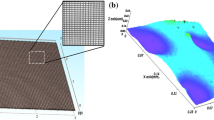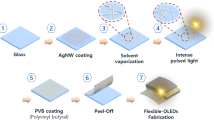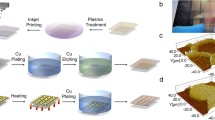Abstract
Flexible transparent electrodes (FTEs) with an embedded metal meshes play an indispensable role in many high-performance optoelectronic devices due to their excellent mechanical stability and low-surface roughness. However, great challenges remain for achieving simple, cost-effective, and environmentally friendly manufacturing of FTEs with embedded metal mesh. In this work, a vacuum-free, mask-free, and plating-free fabrication technique is proposed for FTEs with embedded silver (Ag) mesh by combining an ink-jet printing technique and a newly developed eco-friendly polymer (polyvinyl alcohol) solution-assisted metal transfer process that does not use organic solvents. The fabricated FTEs exhibit excellent optoelectronic performance with an electrical resistance of ~ 1.6 Ω and an optical transmittance at 550 nm of ~ 85.98%. The FTEs with embedded Ag mesh show strong adhesion to the substrate due to their morphology features. The proposed technique offers a promising fabrication strategy with a cost-effective and environmentally friendly process for high-performance printed flexible electronics.
Graphical abstract

Similar content being viewed by others
Explore related subjects
Discover the latest articles, news and stories from top researchers in related subjects.Avoid common mistakes on your manuscript.
Introduction
Flexible transparent electrodes (FTEs) with an embedded metal mesh structure have attracted enormous attention in recent years in the field of high-performance flexible electronic devices due to their excellent mechanical stability, smooth surface (low surface roughness), and photoelectric performance [1,2,3,4,5,6,7]. For this reason, many research results related to the fabrication methods of high-performance FTEs with embedded metal meshes have been reported. Li et al. proposed the fabrication method of the highly robust FTE for flexible heaters with an embedded metal mesh by combining lithography, electroplating, and imprint transfer [4]. Chen et al. adopted ultraviolet nanoimprint lithography technology and electroless deposition process to fabricate FTEs with embedded Ag mesh [6]. Cui et al. produced an embedded copper mesh FTEs for automotive windshield deicing devices via roll-to-roll imprinting, Ag ink scraping, and copper electroplating [7]. Although the proposed methods could provide high-performance FTEs with embedded metal mesh structures, it is difficult to remove photolithography, imprinting, electroplating, electroless deposition, etching, vacuum deposition, other process. This makes the entire process more complex with high production costs and environmentally toxicity [1, 2].
In this work, we demonstrated a vacuum-free, plating-free, and mask/template-free fabrication method for high-performance FTEs with embedded Ag mesh, developed by combining an ink-jet printing technique and a newly developed eco-friendly polymer solution-assisted metal transfer process. First of all, the Ag mesh structure was directly printed on a polyimide (PI) film substrate using an inkjet printer. The polyvinyl alcohol (PVA) solution, which is one of the eco-friendly materials, was then coated using bar coating technique on to the Ag mesh on the PI substrate and completely dried at low temperature. Finally, the FTE with embedded Ag mesh was obtained after peeling the PVA film from the PI substrate. The prepared Ag mesh embedded in FTE with a thickness of ~ 30 μm had better optical/electrical performance and mechanical flexibility than the commercial FTE based on indium tin oxide (ITO) thin film. In addition to this, our FTE also exhibited strong adhesion to the PVA substrate.
Experimental methods
Preparation of FTEs with embedded Ag mesh
Figure 1e shows the fabrication method of the FTE with embedded Ag mesh. First, the Ag mesh structure was printed onto a PI film by a ink-jet printer (DragonFly IV System, Nano Dimension) [8,9,10]. The Ag mesh structure adopted in this study was designed with a line width of 130 μm, a line spacing of 5000 μm, and a thickness of 25 μm. A 20 wt% aqueous PVA solution with viscosity of ~ 20,000 cP was coated using bar coating method to the Ag mesh structure on the PI film and dried in a drying oven at 55 °C for 30 min. After completely curing the PVA solution, the Ag mesh embedded in PVA film could be easily separated from the PI film substrate.
Optical, electrical, and structural characterization
Optical transmittance spectra of the prepared FTEs were obtained using a UV–vis–NIR spectrometer (Cary UV–vis–NIR, Agilent) with air as a reference. The electrical conductivity of the FTE was evaluated by measuring resistance using a digital multimeter (FLUKE 117). The surface of the FTE was analyzed using an optical microscope (BX51, OLYMPUS).
Results and discussion
Figure 1a–d show a photograph of samples generated during the fabrication process of a FTE with an embedded Ag mesh structure. Figure 1a and b show the Ag Mesh structure directly printed on the PI film and the dry state after coating the PVA solution on the surface, respectively. Here, the size of the printed area was 150 mm wide and 30 mm long. For this study, the fabricated final product of the FTE with embedded Ag mesh is shown in Fig. 1c. Figure 1d shows the remaining PI film substrate after transfer-printing of the Ag mesh structure. As shown in Fig. 1a–d, the Ag mesh structure could be successfully transferred from the PI film substrate to the PVA substrate in an embedded state. It means that we could simply fabricated the FTEs with eco-friendly process.
Figure 2a and b show microscopic images of the surface of Ag mesh printed on the PI substrate and the Ag mesh transfer-printed to the PVA substrate, respectively. As shown in the figures, no physical damage was found in the Ag mesh structure before and after transfer printing.
The optical transmittance spectra of the Ag mesh printed on the PI substrate, the Ag mesh transfer-printed into the PVA substrate, and the ITO thin film for flexible transparent electrode was depicted in Fig. 3a. As you can see in the figure, the transmittance in the visible range (400–800 nm) of the Ag mesh structure printed on the PI substrate was much lower than that of the ITO thin film. However, in the case of the Ag mesh embedded in PVA substrate, it was found that the transmittance was higher than that of the ITO thin film. This implies that the Ag mesh embedded in the PVA film is suitable to apply to commercial flexible transparent electrodes.
Figure 3b presents that the current and voltage (I–V) curves of the Ag mesh on PI film and the embedded Ag mesh in PVA film were measured by using a two-probe technique with a semiconductor device analyser. This result means there are no current leaking and defects on the both of the FTEs.
As shown in Fig. 4a–c, the mechanical flexibility of the FTEs with the embedded Ag mesh, which is one of the important characteristics for use in wearable electronics applications, was demonstrated with lighting a red light-emitting diode (LED) using the FTEs in a bent and twisted state. There was no visible change in the LED brightness when the FTEs was compressed and twisted. In addition, any significant change in the brightness of LED connected to the FTEs was not observed with the adhesion test using eraser and 3 M scotch tape, as shown in Fig. 4d and e. The reason for the excellent mechanical flexibility is due to the embedded structures of the Ag mesh to the PVA substrate. This indicates that the FTEs could be applied to the surfaces of diverse shapes for eco-friendly and bio-friendly devices without any electrical and mechanical defects.
Conclusion
In this study, we succeeded in fabricating a FTE (~ 30 μm thick) with embedded Ag mesh by eco-friendly polymer (PVA) solution-assisted metal transfer process. The fabricated the FTE showed better optical/electrical performance than the commercial FTE based on ITO thin film. In addition, we demonstrated that the embedded Ag mesh structures exhibited strong adhesion to the PVA substrate and excellent mechanical flexibility for the FTE. These results imply that the FTEs based on the embedded Ag mesh in PVA substrate can be applied to green electronics. In the future work, we will also use various conductive inks for mesh structures in PVA substrate for diverse applications in green electronics.
Data availability
All data generated or analyzed during this study are included in this published article.
References
Z. Li, H. Li, X. Zhu, Z. Peng, G. Zhang, J. Yang, F. Wang, Y.F. Zhang, L. Sun, R. Wang, J. Zhang, Z. Yang, H. Yi, H. Lan, Adv. Sci. (2022). https://doi.org/10.1002/advs.202105331
X. Zhu, M. Liu, X. Qi, H. Li, Y.F. Zhang, Z. Li, Z. Peng, J. Yang, L. Qian, Q. Xu, N. Gou, J. He, D. Li, H. Lan, Adv. Mater. (2021). https://doi.org/10.1002/adma.202007772
H.G. Im, J. Jin, J.H. Ko, J. Lee, J.Y. Lee, B.S. Bae, Nanoscale (2014). https://doi.org/10.1039/C3NR05348B
A. Khan, S. Lee, T. Jang, Z. Xiong, C. Zhang, J. Tang, L.J. Guo, W.D. Li, Small (2016). https://doi.org/10.1002/smll.201600309
X. Chen, W. Guo, L. Xie, C. Wei, J. Zhuang, W. Su, Z. Cui, ACS Appl. Mater. Interfaces (2017). https://doi.org/10.1021/acsami.7b11779
H. Zhou, H. Mao, X. Meng, Q. Wang, L. Tan, Y. Chen, Org. Electron. (2019). https://doi.org/10.1016/j.orgel.2019.105408
X. Chen, S. Nie, W. Guo, F. Fei, W. Su, W. Gu, Z. Cui, Adv. Electron. Mater. (2019). https://doi.org/10.1002/aelm.201800991
M. Mariello, T.W.A. Blad, W.M. Mastronardi, F. Madaro, F. Guido, U. Staufer, N. Tolou, M. De Vittorio, Nano Energy (2021). https://doi.org/10.1016/j.nanoen.2021.105986
G. Deng, H. Sun, K. Lv, J. Yang, Z. Yin, B. Chi, J. Appl. Phys. (2020). https://doi.org/10.1063/1.5135632
I. Marasco, G. Niro, L. Lamanna, L. Piro, F. Guido, L. Algieri, V.M. Mastronardi, A. Qualtieri, E. Scarpa, D. Desmaële, F. Rizzi, A. D’Orazio, M. De Vittorio, M. Grande, Microelectron. Eng. (2020). https://doi.org/10.1016/j.mee.2020.111322
Acknowledgments
This work was supported by the Technology Innovation Program (20006408) funded by the Ministry of Trade, Industry & Energy (MOTIE, Korea) and the Korea Innovation Foundation (INNOPOLIS) grant funded by the Korea government (MSIT) (2020-DD-UP-0278).
Author information
Authors and Affiliations
Corresponding author
Ethics declarations
Conflict of interest
The authors have no conflicts of interest to declare.
Additional information
Publisher's Note
Springer Nature remains neutral with regard to jurisdictional claims in published maps and institutional affiliations.
Rights and permissions
Open Access This article is licensed under a Creative Commons Attribution 4.0 International License, which permits use, sharing, adaptation, distribution and reproduction in any medium or format, as long as you give appropriate credit to the original author(s) and the source, provide a link to the Creative Commons licence, and indicate if changes were made. The images or other third party material in this article are included in the article's Creative Commons licence, unless indicated otherwise in a credit line to the material. If material is not included in the article's Creative Commons licence and your intended use is not permitted by statutory regulation or exceeds the permitted use, you will need to obtain permission directly from the copyright holder. To view a copy of this licence, visit http://creativecommons.org/licenses/by/4.0/.
About this article
Cite this article
Kim, HJ., Park, J., Kim, J. et al. Flexible transparent electrode with embedded silver mesh by eco-friendly polymer solution-assisted metal transfer process. MRS Advances 8, 884–888 (2023). https://doi.org/10.1557/s43580-023-00621-2
Received:
Accepted:
Published:
Issue Date:
DOI: https://doi.org/10.1557/s43580-023-00621-2








